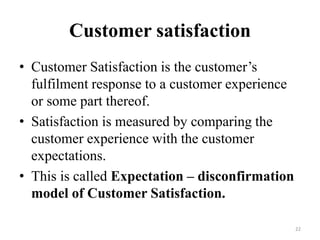Customer Relationship Management (With examples)
- 2. Definition • CRM is a competitive strategy and process of acquiring, reacting and partnering with selective customers to create superior value for the company and the customer. - Parvatiyar and sheth 2
- 3. Why is CRM important ? • Competition • Consumer expectation • Technology • Diminishing impact of advertising 3
- 4. Scope of CRM • Build long term and profitable relationship with chosen customers. • Getting closer to the customers at every point of contact with them. • By fostering customer's loyalty, the company spends less time acquiring new customers and saves then time on other projects. 4
- 5. Piece of software solution. Sales tactics Call center services Another buzzword like ERP / BUSINESS PROCESS MANAGEMENT. 5
- 6. Amul 6
- 7. Relationship Orientation • A relationship is composed of a series of interactive episodes between dyadic parties over time. – Making a purchase – Enquiring about a product – Making a sales call – Negotiating terms – Dealing with complaints • Independence to Dependence to Interdependence 7
- 8. Change within relationship • Awareness • Exploration • Expansion • Commitment • Dissolution 8
- 9. Exploration • Attraction • Communication and bargaining • Development and exercise of power • Development of norms • Development of expectation 9
- 10. Trust • Calculus-based trust • Knowledge-based trust • Identification based trust 10
- 11. Commitment • Trust, Shared values and belief • Trustworthy partners • Size of investment Negatives • Opportunism • High termination cost • Search cost and learning cost 11
- 12. Transaction Vs Relationship • Transaction: Trade of values between parties. – Monetary – Non-Monetary • Relationship orientation: Treating customers in an individualized way. – Long term – Mutually beneficial 12
- 13. Exchange map 1. Good quality, durable planes 2. Fair price 3. On-time delivery 4. Good financing terms 5. Prompt service and availability of spares Boeing FedEx 1. Good price 2. Timely payment 3. Good Word Of Mouth 13
- 14. Transaction Vs. Relationship Marketing Transaction • One off exchanges • Brand management • Short-term focus • Mass communication • Isolated market research • Market share • Profitabilty • Brand equity Relationship • Ongoing exchange • Customer management • Long-term focus • Personal communication • Ongoing dialogue • Mind share • Lifetime value of customer • Customer equity 14
- 15. Why companies want relationship with customers? • Reduce marketing cost • Better customer insight • Lifetime value: Present day value of all net margins earned from a relationship with a customer, customer segments or group of customers. 15
- 16. The customer journey 16
- 17. Why companies do not want relationship with customers? • Loss of control • Exit cost • Resource commitment • Opportunity cost 17
- 18. Why customers want relationship with suppliers? • B2B Context – Product complexity – Product strategic significance – Service requirement – Financial risk • B2C Context – Recognition – Personalization – Status and affiliation 18
- 19. Why customers do NOT want relationships with suppliers? • Fear of dependency • Lack of perceived value in the relationship • Lack of confidence in the supplier • Customer lacks relational orientation • Rapid technological changes 19
- 20. Customer satisfaction, loyalty & business performance • CRM aims to improve the Business performance by enhancing Customer Satisfaction and driving up Customer Loyalty. Customer’s Need and expectation Identification & fulfilment Satisfied customer Repurchase Business Process increases. 20
- 21. … continued • Satisfaction Profit Chain 21
- 22. Customer satisfaction • Customer Satisfaction is the customer’s fulfilment response to a customer experience or some part thereof. • Satisfaction is measured by comparing the customer experience with the customer expectations. • This is called Expectation – disconfirmation model of Customer Satisfaction. 22
- 23. … continued Expectation – disconfirmation model • If experience meet expectation then customers are Satisfied. • Experience > expectation = Positive disconfirmation. • Experience < expectation = Negative disconfirmation. • At times experience meets expectation but still unsatisfied because of low expectation. 23
- 24. Customer loyalty • Loyalty can be defined and measured by two major approach. – Behavioural loyalty. – Attitudinal loyalty. • Behavioural loyalty is measured by reference to customer purchase behaviour and loyalty is expressed in continued buying. • Many companies use RFM measures of Behavioural variables. 24
- 25. … continued R – Recency of purchase (time since last purchase) F – Frequency of purchases (No. of purchase in a given period) M – Monetary value of purchase. • Attitudinal loyalty is measured with reference to Belief, Feeling and purchasing intention 25
- 26. … continued • Two dimensional model of customer loyalty Based on Relative attitude & Repeat purchase behaviour. 26
- 27. Business performance • Measured in two ways – Quarterly profit(or) Earnings/share – Balanced score card(leading companies) • Four Key performance Indicator(KPI) – Financial – Customer – Process – learning & growth 27
- 28. … continued • Implied Connection B/w Indicators is People(learning & Growth) do things (process) for customers(Customer) that have affects on business performance(Financial). • Drivers of Business performance: – Customer outcomes of satisfaction – Loyalty • Share of customer is the popular measure of CRM. 28
- 29. 29





























